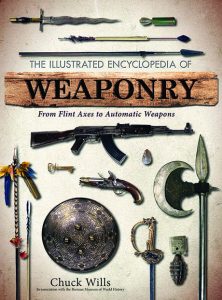Review by
Joseph P. Tartaro | Executive Editor
 THE ILLUSTRATED ENCYCLOPEDIA OF WEAPONRY, by Chuck Wills. ©2016. Published by Thunder Bay Press, San Diego, CA, in association with the Berman Museum of World History, Anniston, AL. Large trade paperback. 320 pages, Price $19.99.
THE ILLUSTRATED ENCYCLOPEDIA OF WEAPONRY, by Chuck Wills. ©2016. Published by Thunder Bay Press, San Diego, CA, in association with the Berman Museum of World History, Anniston, AL. Large trade paperback. 320 pages, Price $19.99.
Available on book stores and online, or direct from publisher online at: Thunderbaybooks.com.
This is an extravagantly illustrated book with plenty of full color illustrations that trace the history of arms from the Stone Age to modern times. The focus is heavily on arms for warfare and defense. While not every type of weaponry is shown, enough are included to provide a sampling of all of the major classes of arms in every era of history.
Relying heavily on rare and unusual collectible items, many from the Berman Museum of History in Anniston, AL, the book traces the development of the first hunting and defense weapons for use against animals and then humans, for food and protection, and in warfare. It places swords and guns within a continuum from century to century.
Most importantly, if explains the differences within weapon classes of each era.
What is the difference between the Plains Indian War Club and the Fijian War Club, for instance? What weapon is common to peoples in every part of the world? The Illustrated Encyclopedia of Weaponry is a comprehensive guide to arms and armaments throughout history.
The Second Amendment Foundation has conducted a number of Firearms and Fiction classes for novelists and scriptwriters over the years in which we tried to educate the people who write narratives that involve firearms particular to understand how and why guns have played such an important part in history and our modern uses not only for defense but for recreational shooting and hunting. These seminars—usually three-day affairs— were divided half classroom and half range work.
As part of these classes, I would try and present a history of arms, beginning with the oldest implements and the Biblical story of David’s victory over the Philistine giant, Goliath, tracing the concept of the sling and sword to modern sidearms and long guns.
The next time we conduct such a seminar, or in any classroom presentation in which we are trying to educate people on firearms and their place in human development, I plan to have a copy, or several copies, of this illustrated encyclopedia.
Beginning in the Stone Age, The Illustrated Encyclopedia of Weaponry travels through the Bronze Age to our present day, showing the tools humans have used to defend themselves all around the globe. There’s the Japanese tanto, or dagger, which has become identified with gangs known as yakuza. There’s the flaming arrow used when Swiss and Austrian forces clashed in the 14th century. And there’s the revolver that Samuel Colt made practical for both military and civilian use in Hartford, Connecticut.
This book will help readers better understand how—and why—the battles of history were fought and why weaponry has developed over time. In the process, it demystifies arms of all classes from the first crude hand cannons to the most modern full automatic individual and crew-served machineguns. Another way to phrase it is that it is a guided tour, as the subtitle promises, from Flint Axes to Automatic Weapons.
This is not just a picture book of edged and projectile weaponry. It is also studded with a variety of authentic history drawings from earlier eras and photos from modern times that add depth and color to the author’s narrative.
The book also offers information on the great innovators in arms, including many TGM readers will be familiar with, including people like Forsyth, Remington, Colt, Winchester, Mosin, the Mausers, Maxim, Browning, Gatling, Thompson, Garand, Tokarev, Gal and Kalashnikov.
The author, Chuck Wills, who unfortunately passed away in 2011 before the age of 50, was an author, editor and consultant specializing in history, particularly military history. In this book, he shares a wealth of knowledge with the reader.
This book includes a great index as well as resource information that highlights the Berman Museum with its five galleries that exhibit items spanning a period of 3,500 years of human history. For the twenty-bucks it costs, this book makes a great arms history resource that should be in the library of every firearms historian, collector or enthusiast.



